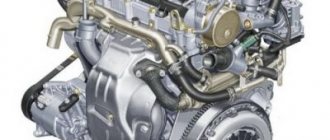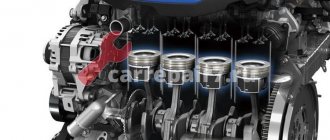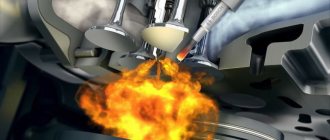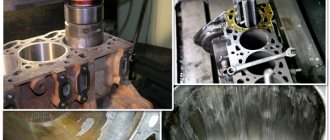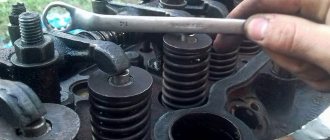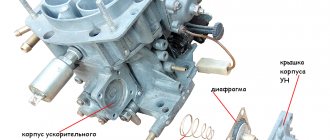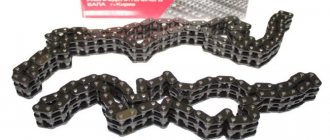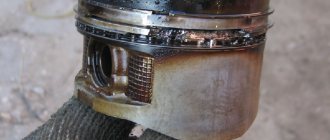W engine
- type of engine with a W-shaped cylinder arrangement. Typically, a W engine is an engine with 3 or 4 banks of cylinders positioned on top at an angle of less than 90 degrees to each other, above a single crankshaft. Thus, in cross section, the engine resembles the letter W. A distinctive feature of this type of engine is its compactness compared to other types of engines used in production cars and having similar power characteristics.
There are also W-twin engines with a staggered in-line arrangement of cylinders in each of two sections of the same cylinder block. Moreover, each of the two sections of such a W-shaped engine has its own cylinder head and the angle between the cylinders (in one section) is 10-15 degrees, as in a conventional VR-shaped engine. The distance between sections in such an engine is less than 90 degrees.
Throughout the history of their existence, W-shaped engines have been used in cars, aviation and motorcycles.
Advantages
The advantages of the W-shaped layout are its relative compactness with the same, and sometimes greater, power characteristics than other types of engines. At the same time, the freed up space in the engine compartment can be used to install additional attachments: power steering, air conditioning compressor, turbocharger, etc.)
A denser arrangement of the cylinders relative to each other allows saving materials in the production of the car.
VR and W: what are the good and bad of in-line engines
In fact, these are two in-row blocks of 8 cylinders - a kind of V-shape assembled from two V-shapes. This scheme is not unique; it was used in a variety of engines with a very different number of cylinders from four inclusive. Even on mass-produced cars!
Italian ancestors
It all didn’t start with VW cars, as you might think. In-line engines appeared under the hood of Italian sports cars. Lancia Lambda was produced from 1922 to 1931 and had 2.1 - 2.6 liter engines under the hood. And the latest version of such a motor was used right up to the seventies. Lancia Fulvia with a V4 engine actually had not a V-shaped, but an in-line engine.
Pictured: Lancia Fulvia '1970–73
Since 1922, Lancia has tested more than a dozen layout options with a camber angle of 10-23 degrees and a displacement from 900 to 2,600 cubic meters. The motors turned out to be compact, with good boost potential, but quite expensive. After all, the cylinder block had to be made of aluminum, the design was complex, and the ignition system was distinguished by the need for precise phase setting and a not very reliable distributor. At a small camber angle, the angle between the contacts of the breaker was too small, and the pulse accumulation time was uneven, which led to the need for further complication of the design. But there was undoubtedly a mechanical advantage, especially in combination with a gas distribution scheme with two overhead camshafts.
In the photo: Under the hood of Lancia Lambda '1922–25
90s and 00s
In 1991, VW introduced its new Corrado VR6 and Passat VR6 models in Europe. In 1992, the VW Golf III VR6 became the first compact hatchback with a six-cylinder engine in its class.
1 / 2
2 / 2
The design of the first VR6 - VW's "in-line-spaced" engines - was optimized for transverse installation and is quite specific. The cylinder angle was 15 degrees, and complex intake manifold tuning was used to compensate for the different lengths of the intake ports. The timing drive on the flywheel side uses two chains: one drives the intermediate shaft, the second drives the camshafts directly.
Pictured: Volkswagen Golf VR6 '1991–1997
The first engines had a displacement of 2.8 liters and 12 valves, and the power was 174 hp. For all-wheel drive Passats, a version with a displacement of 2.9 liters and a power of 190 hp was intended, and later the version with a displacement of 2.9 became the main one for the Golf, Corrado and Passat.
In 1997, they created the VR5 version with a volume of 2.3 liters and a power of 150 hp. The next, 24-valve version of the 2.8 engine was released in 1999: its power was 204 hp; in 2001, a 20-valve version of the VR5 engine also debuted. In the same year, a 3.2-liter VR6 engine version appeared on the Beetle RSi - later it was also installed on the Audi TT and Golf R32. Engine versions after 2005 received direct injection, which was reflected in the model names. Similar engines were installed on the VW Touareg and Porsche Cayenne. And not only on them!
Pictured: Volkswagen New Beetle RSi '2001–03
By the way, there is another funny story connected with VR6. The Mercedes engine of the M104.900 series, which was installed under the hood of the brand’s first minivans, may puzzle many Mercedes engine connoisseurs. Because instead of the classic in-line six of the M104 series, under the hood of the Vito there was a Volkswagen VR6. Yes, yes, exactly with the name of the M104.900 series. The company simply bought a cylinder block with a cylinder head from VW and equipped it with its own attachments, and it received a new designation in the “spirit of the brand.”
In 2008, the engine design was significantly redesigned. The 3.6-liter version retained the general layout, but the cylinder angle was reduced to 10.5 degrees. Such engines were produced only with FSI direct injection, and power increased to 300 hp.
The result of combining two in-line spaced blocks was W-shaped engines with 8, 12 and 16 cylinders, and the “geography” of distribution of such engines, in addition to Audi, where they were used very widely, also included the Bentley and Spyker brands.
Design Features
What was it that Lancia invented that they subsequently began to use so successfully at VW and were able to develop into the engine of the coolest hypercar? It is no secret that the displacement and power of any internal combustion engine are limited primarily for layout reasons. You cannot increase the piston stroke : its average speed increases, and you have to reduce the speed. You cannot increase the cylinder diameter too much: you have to put up with uneven filling, detonation and, again, a decrease in speed.
In the photo: Under the hood of Lancia Fulvia
An increase in the number of cylinders leads to an increase in engine dimensions. And the longer the cylinder block and crankshaft, the more difficult it is to ensure the rigidity of the structure and its operation at high speeds, the more difficult it is to combat torsional vibrations and the higher the mass of the engine. If you switch to a V-shaped cylinder arrangement, the complexity of the gas distribution mechanism increases. The number of block heads doubles, the number of camshafts in the case of their upper location, the intake and exhaust manifolds become more complicated and their number increases...
Of course, as the good saying goes, “it's not the problem, it's the cost,” but for mainstream automakers, cost is an issue, and a big one at that. The essence of the idea of Lancia engineers was that it was possible to limit the camber angle at which all cylinders could be located in one cylinder block, and not in different “half-blocks”. And the design is crowned with only one block head, but a double-row one, in which there is only one set of camshafts.
Articles / Practice Long-stroke and short-stroke motors - what is the difference and which is better? Admit that you have often seen phrases in test drives about “the typically short-stroke nature of the engine” and did not quite understand what they were talking about. Today we will finally tell you what short and long… 89274 6 28 12/15/2016
This design looks like a very “fat” in-line engine. It has an inter-cylinder distance less than the cylinder diameter and only one intake and exhaust manifold. In this case, there is no need to greatly reduce the gap between the cylinder liners to reduce the length of the engine; the cooling channels can be preserved, and the increased thickness of the block can be used to create a more complex coolant circulation pattern. It turns out compact and quite technologically advanced.
A great idea, but its value was truly appreciated only by the end of the 90s, when the need to increase power while reducing engine dimensions and increasing interior volume forced manufacturers to look for new ways and solutions. And the total superiority of the front-wheel drive design with an in-line arrangement of units forced the creation of engine designs that were as compressed in length as possible.
For supercars and simply luxury cars, a compact engine with a large displacement turned out to be a real gift. In this case, the point is not even that the engine is lighter, or that engines of the usual V-shaped design cannot be squeezed under the hood. An extra few kilograms or centimeters are always possible, but an increase in weight and dimensions requires an increase in power, and this, again, is weight or dimensions.
In addition, with increasing power, such a concept as the “thermal package” of the engine becomes more and more important. The more powerful the motor, the more attention needs to be paid to the cooling system; often the maximum power will be limited precisely by the capabilities of the cooling system. And it is limited by the dimensions of the engine compartment and the heat transfer capabilities of the cylinder block. A smaller engine means more space for radiators, better pump performance, better pumpability of the block and cylinder head, and the engine can better withstand operation at elevated temperatures and short-term thermal peaks.
What's next?
Now it seems that engines with an in-line-spaced layout are once again fading from the race: with a working volume of one and a half to two liters, a complex layout is not needed, and two-liter supercharged engines are already registered under the hoods of F-class cars - for example, in the BMW “Seven”. All that remains are the multi-cylinder monsters, which look like an endangered species. But I hope that the elegance of this layout scheme will still be useful, and the masterpieces created on its basis will delight us for many more decades.
Links
| Cylinder arrangement | Inline Engine (U Engine) • Boxer Engine • H Engine • V Engine • VR Engine • W Engine • Star Engine (Rotating) • X Engine |
| Piston types | Free-piston • Engine with counter-moving pistons (delta-shaped) • Axial |
| Ignition method | Diesel • Compression carburetor • Glow-compression • Glow carburetor • Battery ignition • Magneto • Arc and spark plugs |
Carriers
Audi W12 engine 6.3 liters
- Audi AG Audi Avus quattro
- Audi A8 W12 (TFSI W12, 6 liters)
- Bentley Bentayga (W12, 6 liters)
- Bugatti Veyron (TSI W16, 8 liters)
- Spyker C12
- Volkswagen Phaeton
Excerpt characterizing the W-twin engine
Prince Andrei felt that either of all the affairs that occupied the Minister of War, the actions of Kutuzov’s army could least of all interest him, or it was necessary to let the Russian courier feel this. “But I don’t care at all,” he thought. The Minister of War moved the rest of the papers, aligned their edges with the edges and raised his head. He had a smart and characteristic head. But at the same moment as he turned to Prince Andrei, the intelligent and firm expression on the face of the Minister of War, apparently habitually and consciously changed: the stupid, feigned, not hiding his pretense, smile of a man who receives many petitioners one after another stopped on his face . – From General Field Marshal Kutuzov? - he asked. - Good news, I hope? Was there a collision with Mortier? Victory? It's time! He took the dispatch, which was addressed to him, and began to read it with a sad expression. - Oh my god! My God! Shmit! - he said in German. - What a misfortune, what a misfortune! Having run through the dispatch, he put it on the table and looked at Prince Andrei, apparently thinking about something. - Oh, what a misfortune! The matter, you say, is decisive? Mortier was not taken, however. (He thought.) I am very glad that you brought good news, although the death of Shmit is an expensive price to pay for victory. His Majesty will probably wish to see you, but not today. Thank you, take a rest. Tomorrow be on the way out after the parade. However, I'll let you know. The stupid smile that had disappeared during the conversation reappeared on the face of the Minister of War. - Goodbye, thank you very much. The Emperor will probably wish to see you,” he repeated and bowed his head. When Prince Andrei left the palace, he felt that all the interest and happiness brought to him by the victory had now been abandoned by him and transferred to the indifferent hands of the Minister of War and the courteous adjutant. His whole mindset instantly changed: the battle seemed to him like an old, distant memory. Prince Andrei stayed in Brunn with his friend, the Russian diplomat Bilibin. “Ah, dear prince, there is no nicer guest,” said Bilibin, going out to meet Prince Andrei. - Franz, the prince’s things are in my bedroom! - he turned to the servant who was seeing Bolkonsky off. - What, a harbinger of victory? Wonderful. And I’m sitting sick, as you can see. Prince Andrei, having washed and dressed, went out to the diplomat’s luxurious office and sat down to the prepared dinner. Bilibin calmly sat down by the fireplace. Prince Andrei, not only after his journey, but also after the entire campaign, during which he was deprived of all the comforts of cleanliness and grace of life, experienced a pleasant feeling of relaxation among those luxurious living conditions to which he had become accustomed since childhood. In addition, after the Austrian reception, he was pleased to talk, at least not in Russian (they spoke French), but with a Russian person who, he assumed, shared the general Russian disgust (now especially vividly felt) for the Austrians.
